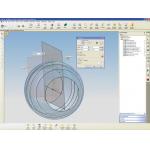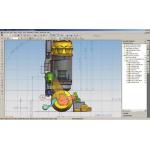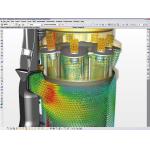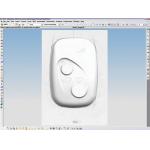Latest News
March 1, 2006
By Al Dean
Each release of a system with the breadth and depth of coverage of UGS’ NX is going to be a major event, but when that system is undergoing the rapid development that NX currently is - it’s a breathtaking endeavor. That said, I’m going to try and pick through the release and find some of the differentiators I think are interesting, either for their originality or for shear user benefits. First up? Usability.
In the world of software, usability is often solely centered on the new user, so it’s refreshing that NX 4 sees work done to make life easier for the not only the new or casual user, but also the existing power users. In the new/casual user camp, the biggest news is the introduction of a Roles-based environment.
Roles-Based UI
Roles allow you to store interface configurations that can be dragged from the Part Navigator. This readjusts the user interface (UI), displaying specific functions, hiding others, and adapting those presented (icon size, text tips, etc). Using New User role, this adapts the UI for maximum discoverability and learning. For experienced users, Roles is a method of presenting your most commonly used tools—whether that’s an arbitrary selection, favorite tools, or task-specific roles for surface design, assembly modeling, sheet metal, etc., is up to you.
Alongside the UI configuration tools, there’s also been core work on making the user experience more consistent. Here we’re talking about how you interact with features and their variables, using drag handles and “on-model” parameter editing rather than dialogs. Also for NX 4, instead of having separate solid/surface commands (for revolve, extrude, blend, chamfer, etc.), these have been consolidated to create both surface geometry types from within the same operation. This gives you the benefit that learning is simpler and features can be readapted easily—i.e., you can switch a feature from a solid to a surface and vice versa.
Also, when creating features such as extrudes, trims, and drafts, you now have greater control over the process. For example, in the extrude and trim areas, you can opt to have the system output multiple bodies, while in the offset and draft operations, you can now define multi-values to specific faces within a single feature. The benefits are that products can be defined with fewer features, as more cases can be handled within a single feature. Also, this means that the part history is simpler, which has downstream benefits when propagating design modifications.
|
|
| UGS NX 4 |
‹ ‹ NX 4 sees usability enhancements continue, with consolidation and rationalization of many core-level commands. You now have the ability to create either solids or surfaces in the same feature (and edit that option after the fact), as well as allow multiple values and body creation for draft, shells, and such.
Elsewhere, NX 4 sees technology implemented at a baseline level to allow for the effective management of a systems-based or top-down design from first principles. Much of this is geared toward the use of sketch or 2D-based geometry to initially layout a product and use that sketch geometry as the base on which the development process is controlled. To make this feasible, NX’s 2D core has been reworked to support the creation and management of extremely large 2D layouts and schematics—think 10,000+ of entities. Sketch bandwidth aside, other work allows you to make much more use of color and grouping, which allows you to quickly distinguish between separate entities, systems, and subassemblies in 2D.
Taking this further, there are other new tools that make the use of this skeletal data much more efficient. For example, you can now select a set of geometry and control-drag them. This not only replicates the geometry, but all associated dimensions, and constraints—saving rework. Taken further, when linked with the knowledge-capture tools (WAVE), then you have a very efficient method of controlling a complex product structure using a 2D lightweight/schematic representation, where modifications are propagated at a very high level, then rolled out through the 3D assembly model.
Simulation
Simulation and analysis is something that UGS is working very heavily on these days and with all the action in the market from other vendors, it’s no wonder. This NX release adds new tools that work to both extend the core functionality to cover new areas like fluid flow, as well as to optimize the whole process. Following the simulation workflow, the updates range from improved meshing tools that afford the user greater control over both abstraction (read: de-featuring) and meshing of complex geometry such as fillets and shells—and general mesh robustness.
|
|
| UGS NX 4 |
› › The revamped 3D sketch and layout tools now let you create very large schematic-style sketches and manage the content using colors and groups within the product structure. Taken further, and in conjunction with WAVE technology, this allows a top-down control of complex 3D geometry using a lightweight schematic-style method.
Moving forward, there has been much effort to expand the range of coverage of the CAE tools, in the areas of nonlinear, thermal, and fluid flow analysis as well as more specific tools to handle rotor dynamics. Of course, the postprocessing tools have also been improved inline with the new technology, allowing the user to visualize and interact with results data—for example, vector-based flow display for fluid or heat transfer as well as more generically applicable graphing, charting, and tabulation tools. The Simulation Process Studio (initially introduced in the NX 3 release) allows an organization to take its in-house analysis and simulation knowledge and best practices and formalize them into reusable templates or wizards that can then be more widely implemented, as control is retained by the authoring specialists.
I-deas Parity
One particular area of interest was a collection of features that have been transferred across from the I-deas product set to extend or compliment the existing NX tools and to provide parity between the two systems. An excellent example is the Emboss tool. This is perhaps most commonly used in the automotive, body-in-white process to create mounting features and weld/assembly features, but handles complex forms where both offsets and radii are required. Also, the variation sweep tools have been updated within NX to match the widely operation within I-deas. Of course, in addition to porting across modeling functionality, this also has impacts in improving data interoperability between the two product sets.
|
|
| UGS NX 4 |
‹ ‹ To provide backup for the range of analysis and simulation tools introduced or enhanced with this release, NX 4 also sees support provided for the postprocessing of such work—here, the new flow vector display tools are used.
Sheet Metal
One area that’s been grown within NX is the support it provides for sheet metal and manufacture. Yes, much of this technology is a direct port of the operations found within UGS’ Solid Edge product (which has an enviable reputation in the field), but that doesn’t mean that that NX doesn’t add anything to the mix. NX 4 has the usual flanges, cut-outs, corner treatments and stamped feature libraries, it also includes tools to rip apart solid models to create sheet metal parts (ideal for redesign of specific forms to change methods of manufacture). Alongside this, it also has a number of specific tools for the creation of aerospace-specific sheet forms, such as Aerospace Flanges and Joggles and a specific Unform/Reform tool.
Drafting
No release is complete without a nod toward drafting. NX 4 sees work done all across the board, but one area I’m keen to talk about is 3D PMI or Product Manufacturing Information. If you’re staring at the page blankly thinking “What?” this allows the user to take established dimensioning and annotation methods into 3D. It allows you to store all of the GD and T that you’d traditionally store within a 2D drawing and fully document a design in 3D. This release sees the existing tools enhanced with both usability and greater support for ASME’s Y14.41-2003 standard. You can now view and edit PMI within the Part Navigator (the feature tree), create and reuse 3D sections views when modeling, display PMI on natural planes. Of course, one of the benefits of annotating a 3D model is when generating a 2D drawing as much of that vital information can be extracted automatically.
Managed Development Environment
Despite the advances being made in the NX area, the real jewel in the crown for UGS is its TeamCenter product portfolio. It’s probably one of the handful of true enterprise tools available for managing the product development, manufacturing and post sales/in-field workflow and its adoption is widespread across many industries, from the usual automotive and aerospace ventures and into more esoteric areas, such as apparel. This NX release sees the linkage between NX and Teamcenter enhanced to ensure that users adopting both systems can reap the most rewards from that synergy of product development tools and data management. The concept is that everything done in NX is able to be fully managed by TeamCenter (whether that’s 2D or 3D data, documentation, spec sheets, analysis inputs and results). There are also tools that allow you to kick off the collaborative or business process from within NX, without too much recourse the Teamcenter environment. A solid example is the Stage Gate review that allows you to parcel up all your relevant product information and distribute in a controlled manner to those involved in the approval/sign-off process in an informal, but managed collaborative manner.
|
|
| UGS NX 4 |
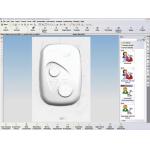
On the left above is the UGS NX 4 interface with the Default Role applied. As you’ve probably guessed, this is the default user interface and comes as standard. On the right above is an example of the Essentials Role. When you apply the Essentials Role, you adapt the NX 4 user interface for new or infrequent users. The Essentials Role intreface provides the operator with basic geometry creation tools, with text under the icons to immediately
convey the function underneath.
Meanwhile on the right, the Advanced Role interface removes the icon text and adds more advanced functions. This again is a system default role shipped with NX 4 and is for more experienced users who are well-versed with the icons and are looking to utilize advanced geometry creation tools and functions as part of their daily tasks. Click images to enlarge.
Conclusions
UGS is an organization with a master plan. Granted, that’s not a particularly rare thing in the software world by any means. Other vendors are announcing grand schemes and their visions for the future but bring little to market. UGS however is delivering on the roadmap it announced after the merger with SDRC and has been doing so consistently with each release. Looking at the progression from NX 3 to NX 4, it’s clear that its next generation platform is developing at an incredible rate. Here we’ve covered all manner of updates which bring advanced technology into the NX environment—particularly in the simulation domain (no pun intended for those CFD users out there). There are other others that haven’t been talked about, such as Human Modeling, but hey, we’ve only got so much space.
Alongside this, I find the work done on some of the core-level functionality intriguing. Making 2D layouts efficient in both terms of data handling and geometry manipulation is good solid stuff, but the fact that this can then be used to drive a complex 3D product definition is incredibly useful, whether that’s in machinery design, auto/aero development, or consumer products. Also, usability, as I’ve said, is something many vendors miss out on, but here, with the introduction of the Roles-based UI control and the work done to consolidate and simplify the modeling process mean that brand new users, casual existing users, and experienced users can derive benefits together. Can’t wait to see what UGS has in store for NX 5.
Al Dean is Technology Editor of the UK’s leading product development and manufacturing journal, MCAD and is Editor of Prototype, for the rapid prototyping and direct manufacturing industry, both available by clicking here. Send your comments about this article through e-mail by clicking here. Please reference “NX 4, March 2006” in your message.
Product Information
NX 4
UGS Corp.
Plano, TX
Subscribe to our FREE magazine, FREE email newsletters or both!
Latest News
About the Author
DE’s editors contribute news and new product announcements to Digital Engineering.
Press releases may be sent to them via [email protected].







